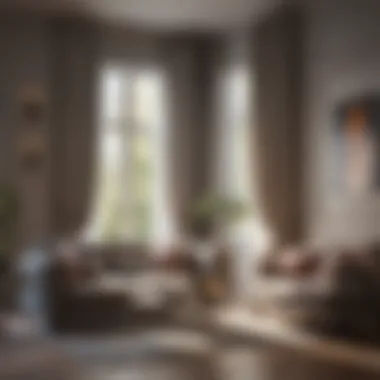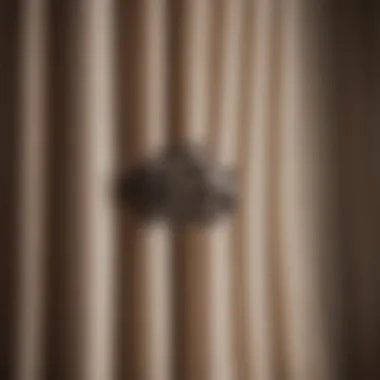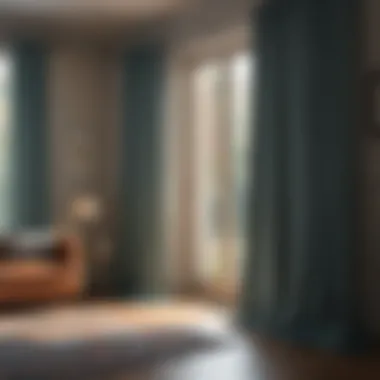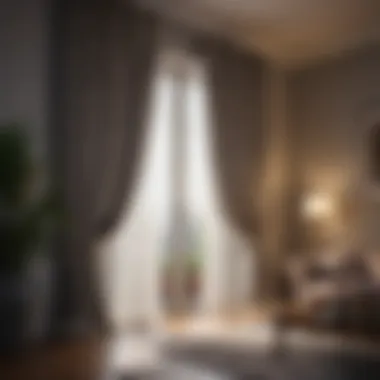Expert Guide to Hanging Side Panel Curtains


Intro
Hanging side panel curtains might seem like a straightforward task, but there’s a bit more to it than meets the eye. This guide takes a closer look at the nuances involved in achieving a well-finished curtain setup. Whether you want to frame your windows elegantly or create a cozy nook in your living space, understanding the methods and materials that go into fitting these curtains is essential. The right approach can transform an ordinary room into an inviting retreat, lending character and flair to your home.
As you embark on this curtain journey, it’s crucial to consider trending design inspirations as well as practical considerations such as measurements and material choices. When you know what’s out there in terms of styles and hues, you’re better equipped to decide what fits best in your space while serving the functionality you desire.
So grab your measuring tape, maybe a pencil, and let’s delve into the art of hanging side panel curtains!
Prelims to Side Panel Curtains
Hanging side panel curtains may seem like a simple task, but there’s more to it than just draping fabric at your windows. These curtains serve as a striking architectural feature that can dramatically enhance the ambiance of any room. Integrating side panel curtains into your decor not only adds a touch of elegance but also showcases the stylistic intentions of your space. When executed correctly, they can transform a mere window into the centerpiece of the room, catching the eye and pulling the entire design together.
The potential for customizing side panel curtains is vast. From sumptuous fabrics to various widths and lengths, there’s much to consider as you embark on this endeavor. The importance of understanding your space, the natural light you seek to control, and the overall style you represent should guide your choices.
While it might seem straightforward, some common missteps can dull the luster of your curtains. Not taking precise measurements or opting for incompatible materials can lead to a less-than-satisfying appearance. Therefore, laying down a solid foundation of knowledge about side panel curtains is crucial. This can empower homeowners, interior design enthusiasts, party hosts, and even gardening aficionados to make informed choices that align with their vision.
"A room without curtains is like a book without a cover—lacking character and context."
Let's delve deeper into what side panel curtains are and explore the vital design considerations that can help achieve that polished and sophisticated look.
Choosing the Right Curtains
Choosing the right curtains is a significant step in the journey of decorating any space. It is not just about selecting a piece of fabric; it’s about setting a tone, creating an atmosphere, and elevating the overall aesthetic of a room. The curtains you choose can make or break the look you are aiming for, affecting light control, privacy, and even the perceived size of a room. Therefore, navigating through the options thoughtfully can yield various benefits that resonate with your unique style and functional needs.
When selecting curtains, understand that they should complement your existing decor while also embodying the functionality you desire. For instance, if you’re after a cozy, warm environment, heavier fabrics like velvet might be the way to go, whereas, for a more airy and bright vibe, sheer materials can be perfect. Moreover, the right choice also plays an important role in energy efficiency, as heavier drapes can help insulate against outside temperatures.
Types of Fabrics and Textures
Various fabrics and textures can be utilized for side panel curtains, and each type carries its own personality and suitability. Here’s a breakdown of some popular options:
- Cotton: A versatile favorite. Easy to clean and durable, cotton curtains come in a plethora of prints and colors. They can range from lightweight and sheer to heavier weaves.
- Linen: Known for its crisp and natural texture, linen offers a breezy feel, perfect for a beach house. However, it does wrinkle easily, so keep that in mind.
- Polyester: This synthetic fabric is a practical choice due to its resilience and wide range of colors and patterns. It often mimics the appearance of natural fabrics without the upkeep.
- Velvet: Luxurious and thick, velvet drapes can add a touch of opulence to your space. They’re great for sound absorption, bringing an intimate feel.
- Silk: Elegant and light, silk naturally shines, but it requires special care and may not be the best choice for high-traffic areas.
Choosing the fabric is about more than just visual appeal; it's about how you want the room to feel and function. Make sure to think about practicality alongside aesthetics.
Color Palettes and Patterns
Color palettes and patterns are the icing on the cake. The hues you choose can influence the mood of the space and how it interacts with light. Here’s some advice:
- Neutral Tones: Whites, beiges, and grays allow for flexibility in styling. They work wonderfully as a backdrop, letting other decor elements speak loudly.
- Bold Colors: Reds, blues, or yellows can become a statement piece, drawing the eye and adding personality.
- Patterns: Floral, geometric, or abstract patterns can inject character into a room. Remember, balance is key; if your room has a lot of busy elements, opting for simpler patterns may be smoother on the eyes.
Choosing the right curtains involves a dance between fabric, texture, color, and pattern. Each can significantly influence the feeling of a space and shouldn't be decided lightly.


Essential Tools and Materials
When gearing up to hang side panel curtains, it's crucial to have the right tools and materials at your disposal. Not only does this streamline the process, but it also ensures that the final look is polished and tailored to your space. Getting the right tools on hand before starting not only reduces frustration but can save you time and energy down the line.
Measuring Tools
To make the most of your curtains, precise measurements are vital. Relying on just your eye can lead to curtains that either drag on the floor or leave unsightly gaps at the edges. Here’s a snapshot of what you should keep on hand:
- Tape Measure: A flexible, long piece of metal or cloth that will give you precise measurements. It’s best to use a cloth tape measure, as it can easily wrap around corners or curves.
- Level: A simple tool that shows whether your curtain rods will be hanging straight. It’s the little things that make the difference, and a level keeps everything looking professional.
- Pencil or Marker: Marks on the wall can be annoying but leaving marks is often necessary to indicate your measurements before you drill. Just be sure to use something that can be easily erased or painted over.
Taking accurate measurements helps keep your space looking neat. For instance, if your curtains are intended to frame a window, they need to have the right width and length to fulfill that role without overshadowing other design elements in the room.
Curtain Rods and Accessories
Selecting the right curtain rod is like choosing the right frame for a painting. It’s the unsung hero of curtain installation, as it holds everything together while adding to the overall aesthetic. Here are some key considerations:
- Material: Curtain rods come in various materials like wood, metal, or even plastic. Metal rods can add a modern touch, while wooden rods impart warmth and charm.
- Diameter: The thickness of the rod can affect the rod's strength. A thicker rod generally supports heavier curtains better than a thinner one.
- Finials: These are the decorative ends of the curtain rod. They can be simple or elaborate, and choosing the right design can either enhance or detract from your decorative scheme.
- Brackets: Don’t overlook these essential bits. Brackets secure the rod to the wall. Make sure they’re suitable for your rod's width and strength to avoid any accidents that could come from a poorly installed rod.
Fastening Options
Fastening methods can dictate how your curtains will hang and move. Understanding your options here plays a major role in both functionality and style:
- Hooks: Commonly used with pin-on tape, hooks can give you flexibility in how much fabric hangs over the rod.
- Clip Rings: These allow for easy opening and closing of curtains. They slide along the rod and can be a chic way to let light in without the hassle of removing the curtains entirely.
- Tiebacks: If you want to create a relaxed, breezy look, tiebacks are perfect. They hold the curtains back, allowing natural light to flood your space without completely abandoning your window coverings.
It's essential to match your fastening options not only to your curtains but to the overall design and functionality you wish to achieve.
Equipped with the right tools and materials, hanging your side panel curtains will seem less daunting and more like a rewarding home improvement project.
Taking Measurements
Taking measurements is a cornerstone of hanging side panel curtains. This stage may seem mundane, but do not underestimate its importance. Proper measurements ensure that your curtains fit just right, enhancing the overall look and functionality of your space. Not only does incorrect measuring lead to potential design mishaps, but it could also require additional time and expenses to rectify those errors. By adhering to precise measurement techniques, you can avoid being stuck with curtains that are too short, too long, or worse—the wrong style altogether.
Measuring Width and Length
When it comes to measuring width, it’s the starting point of your curtain installation journey. Begin by taking the total width of the window you wish to adorn. It's advisable to extend the measurement a bit past the window frame by about 3 to 6 inches on each side. This adjustment allows for a fuller, more luxurious appearance when you draw the curtains to the sides.
Next, for the length, think about how you want your curtains to fall. A few popular options include:
- Floor length: This look offers a formal touch and makes ceilings appear higher.
- Sill length: If practicality is your goal, this style may suit smaller windows or spaces where movement is necessary.
- Puddle effect: For dramatic flair, allowing the fabric to lightly pool on the floor can lend an air of elegance.
Use a steel measuring tape for accuracy. Measure from the desired starting point—whether that’s the top of the window frame, ceiling or another location—down to the point where you want your curtain to end. It's better to measure twice and cut once than to be left with awkward lengths!
Determining Height Placement


Determining the height at which to hang your curtain rod is crucial for achieving the right ambiance in a room. Hanging too low can make a space feel cramped, while too high can lack balance. A general rule of thumb is that you should hang curtain rods about 4 to 6 inches above the window frame or panel. However, to create an illusion of higher ceilings, consider placing the rod closer to the ceiling.
Here are some considerations to keep in mind while finding that sweet spot for height placement:
- Room Style: Contemporary designs often favor higher placements, while traditional styles might remain closer to the window.
- Furniture Placement: If you have furniture that may obstruct curtain flow, such as a sofa, make sure to accommodate that in your height measurements.
- Light Control: Consider how you want natural light to enter your room. The placement will impact how much light is allowed through when curtains are drawn.
"Good design always begins with proper measurements. Take your time to get it right."
Adhering to these guides, you can confidently head into the next stage of your curtain hanging journey with a clear understanding of how to measure correctly.
Installation Process
Hanging side panel curtains might seem like a simple task, but the installation process plays a pivotal role in achieving the desired aesthetic and functionality of your space. Proper installation not only enhances the visual appeal but also ensures that the curtains operate smoothly, allowing for optimal light control and privacy. A well-executed installation can transform a room, making it feel polished and thoughtfully designed. Thus, it's crucial to approach this phase with attention to detail.
Preparing the Wall
Before you dive into hanging your lovely curtains, the first step is all about preparing the wall. This part of the process is essential because a smooth and even surface means you won’t be chasing after any hiccups later on. Start by examining the area where you plan to mount the curtain rod. Make sure there's no dust or grime. A good wipe down with a damp cloth can work wonders.
Next, measure the height and width carefully. Use a stud finder to locate wall studs, especially if you're dealing with heavier fabric. Mounting into a stud can offer stability and prevent issues down the line. If the wall’s coverage is uneven, consider adding a bit of shim to level out the mounting bracket. It’s best to ensure that the rod will sit flat against the wall and not veer off while carrying those beautiful curtains.
Mounting the Curtain Rod
Now that your wall is prepped like a pro, it’s time to get that curtain rod up, which is where things can get a bit tricky if you’re not careful. Make sure you have all the necessary tools handy: a power drill, screwdriver, level, and potentially a friend to help hold everything in place. You don’t want to be wrestling things alone!
Position the brackets according to your measurements and mark the spots with a pencil. The brackets should be located about four to six inches above the window frame to create an illusion of height. Once the brackets are securely installed, it’s time for the show-stopping moment; hang the rod! Check once more with the level to guarantee it’s straight, because nobody wants their curtains draping at an awkward angle.
Hanging the Panels
Finally, we move onto hanging the curtains themselves; the cherry on top of your interior design. Depending on the style of your curtains, you may need to slide the panels onto the rod or clip them with hooks. If you’re going for a more dramatic flair, consider a ripple fold or pinch pleat style—they add that touch of elegance.
After securing the curtains, take a step back and assess the flow. Adjust them slightly if they don’t hang evenly. It’s often the little tweaks that can bring everything together seamlessly.
"A little bit of patience during installation can lead to a big reward in the aesthetics of your space."
Finally, once everything is up and looking fab, give yourself a pat on the back. Enjoy your newly dressed windows, which not only add character to your room but also demonstrate your impeccable taste.
Styling and Arranging the Curtains
Creating a well-styled and arranged curtain setup can significantly elevate the ambiance of any room. Curtains are not just functional elements that offer privacy and light control; they also serve as integral design statements that can tie together the overall decor of your space. Done right, styling and arranging side panel curtains can create visual layers, enhance space perception, and contribute to the overall harmony of your home.
Creating a Layered Look


A layered look can breathe life into plain walls and create a sense of depth in your room. Think of it like dressing up a space: just as you might layer clothing for style and warmth, layering curtains can bring both elegance and functionality to your windows.
- Complementary Fabrics: To achieve a layered look, consider combining different textures and fabrics. For instance, pair heavier drapes (like velvet) with sheer panels that can softly diffuse light. This not only adds richness to your space but also allows for flexibility in light control.
- Use of Color: Play with color contrasts or complementary tones. A light-colored sheer panel layered over darker drapes can create a lovely backdrop, allowing you to maintain brightness while adding depth. Don’t shy away from patterns, but be mindful they should harmonize well instead of competing for attention.
- Hanging Techniques: Think about innovative hanging techniques. For example, using multiple rods can help create an eye-catching layered effect that draws the gaze upward, making the ceiling feel higher than it is. Careful spacing of panels can also contribute to a more open, airy feel, which is often desirable in smaller rooms.
"Layering is not just about adding fabric; it’s about creating a narrative that works visually and emotionally in your space."
Adjusting for Light Control
Light control is perhaps one of the most practical considerations when it comes to curtain arrangement. The ability to manage how much light enters a space can dramatically alter its mood and usability. Here are a few key points to keep in mind:
- Layering for Functionality: When styling panels, consider placing sheer fabrics on the inside and heavier curtains on the outside. This setup enables you to enjoy natural light during the day while still having the option to block the light at night for privacy.
- Angle and Orientation: Be conscious of the window's orientation in relation to sunlight. For south-facing windows that receive a lot of rays, sheer panels can diffuse the harsh sunlight while thicker drapes can be pulled back during cooler months to maximize heat.
- Automatic Solutions: In today’s tech-savvy world, there are smart curtain systems that allow you to control light at the touch of a button. For example, automation not only adds convenience but can also help in managing energy costs effectively by regulating temperature and light based on the time of day.
In arranging and styling your side panel curtains, the key is to find a balance between aesthetics and functionality. Consider how each element plays into the overall design and purpose of the space, and don't hesitate to experiment until you find the perfect look.
Maintenance and Care
Caring for your side panel curtains goes beyond just hanging them neatly. Regular maintenance ensures that they continue to enhance your decor while lasting for years. Understanding the role of maintenance not only protects your investment but also keeps your home looking its best.
Cleaning Techniques
Cleaning curtains might seem like a mundane task, but it can significantly affect their lifespan and appearance. Here are some effective techniques to keep those curtains spotless and vibrant:
- Dusting Regularly: Lightly dust your curtains with a microfiber cloth or a soft brush at least once a week. This prevents dirt from building up, which can lead to discoloration and fabric degradation over time.
- Vacuuming: For heavier fabrics, using a vacuum with an upholstery attachment is an excellent way to remove dust and debris without taking the curtains down. Be gentle to prevent pulling threads or damaging the fabric.
- Spot Cleaning: Kids, pets, or just life can lead to unexpected stains. Keep a gentle fabric cleaner handy to treat spots immediately. Dab, don't rub, to avoid spreading the stain further.
- Machine Washing or Dry Cleaning: Always check the care label first. If your curtains are machine washable, do so on a gentle cycle with mild detergent. For delicate fabrics like silk or those that are dry clean only, it’s best to take them to a professional.
"Keeping curtains clean not only preserves their beauty but also enhances the entire room’s ambiance."
Preventive Measures
Prevention is always better than cure, especially when it comes to home decor. Here are some preventative steps to extend the life of your side panel curtains:
- Avoid Direct Sunlight: UV rays can fade fabrics over time. If possible, consider using sheer liners or installing window treatments to shield your curtains from harsh sunlight.
- Choose High-Quality Fabrics: Investing in durable materials can save you time and money in the long run. Fabrics like polyester or treated cotton hold up better against stains and wear.
- Install Curtains Properly: Ensure that your curtain rods and hooks are secure. Poor installation can lead to tears or unexpected falls.
- Regular Inspections: Periodically check for any signs of wear – frayed edges, loose threads, or fading. Catching these issues early can prevent larger problems down the road.
Maintaining and caring for your side panel curtains is essential for sustaining their aesthetic appeal and functional longevity. Through regular cleaning and preventive measures, you can ensure that they continue to bring warmth and style to your space.
End
At the end of this journey into the world of side panel curtains, it’s critical to reflect on the importance of what has been discussed. Understanding how to properly hang side panels not only enhances the visual appeal of a room but also maximizes functionality. With the right considerations, you can transform your living space, offering both charm and practicality.
Recap of Key Steps
Before we wrap things up, let’s quickly skim through the key steps highlighted throughout this guide:
- Choosing the Right Curtains: Selecting fabrics and colors that complement your space is vital. Always consider texture and pattern, making sure they align with the overall theme of your home.
- Essential Tools and Materials: Gathering the proper tools like measuring tapes, curtain rods, and the right mounting hardware sets you up for success.
- Taking Measurements: Accurate measurements prevent costly mistakes and ensure your curtains hang perfectly.
- Installation Process: Proper installation techniques are crucial, ensuring that the curtains enhance rather than detract from your space.
- Styling and Arranging: Taking time to arrange your curtains thoughtfully can create a layered look that feels intentional and stylish.
- Maintenance and Care: Regular cleaning and preventive measures keep your curtains looking their best and extend their lifespan.
Final Thoughts on Design Integration
Integrating side panel curtains into your home isn’t just about aesthetics; it’s about creating a harmonious environment. They serve as a bridge between functionality and design. When positioned correctly, they can control light, improve privacy, and add warmth to your space. Furthermore, the right side panels can accentuate architectural features, drawing the eye to elements that might otherwise go unnoticed.
As you move forward with your design choices, remember that every element counts. Blending these curtains with your overall decor can make all the difference in how a room feels. Whether you're creating a cozy nook or a formal living area, side panel curtains can be just the touch you need.















